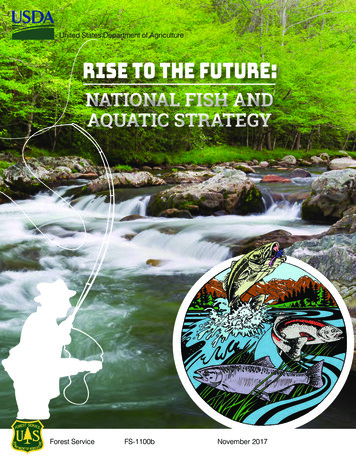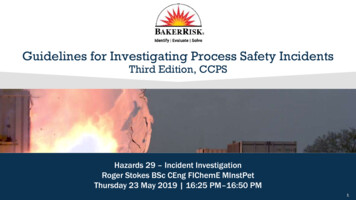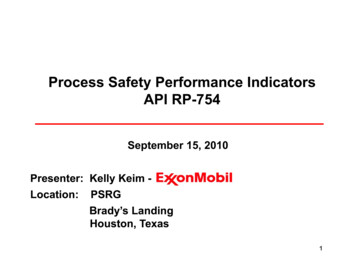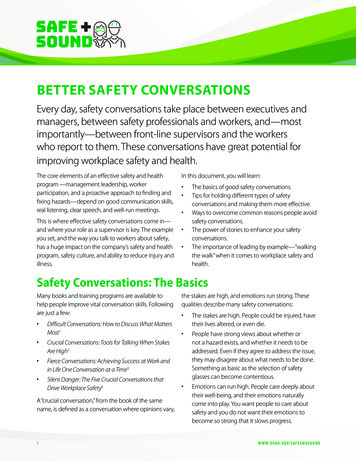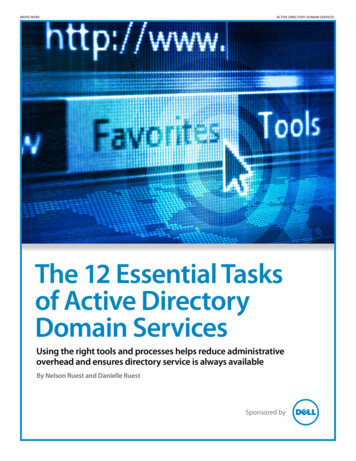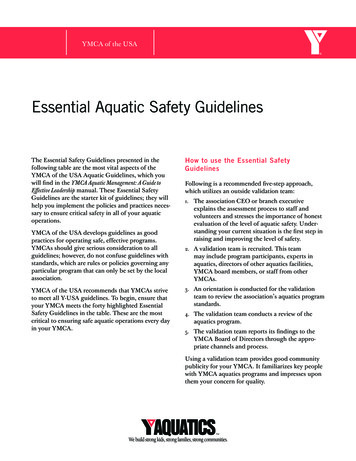
Transcription
YMCA of the USAEssential Aquatic Safety GuidelinesThe Essential Safety Guidelines presented in thefollowing table are the most vital aspects of theYMCA of the USA Aquatic Guidelines, which youwill find in the YMCA Aquatic Management: A Guide toEffective Leadership manual. These Essential SafetyGuidelines are the starter kit of guidelines; they willhelp you implement the policies and practices necessary to ensure critical safety in all of your aquaticoperations.YMCA of the USA develops guidelines as goodpractices for operating safe, effective programs.YMCAs should give serious consideration to allguidelines; however, do not confuse guidelines withstandards, which are rules or policies governing anyparticular program that can only be set by the localassociation.YMCA of the USA recommends that YMCAs striveto meet all Y-USA guidelines. To begin, ensure thatyour YMCA meets the forty highlighted EssentialSafety Guidelines in the table. These are the mostcritical to ensuring safe aquatic operations every dayin your YMCA.How to use the Essential SafetyGuidelinesFollowing is a recommended five-step approach,which utilizes an outside validation team:1.The association CEO or branch executiveexplains the assessment process to staff andvolunteers and stresses the importance of honestevaluation of the level of aquatic safety. Understanding your current situation is the first step inraising and improving the level of safety.2. A validation team is recruited. This teammay include program participants, experts inaquatics, directors of other aquatics facilities,YMCA board members, or staff from otherYMCAs.3. An orientation is conducted for the validationteam to review the association’s aquatics programstandards.4. The validation team conducts a review of theaquatics program.5. The validation team reports its findings to theYMCA Board of Directors through the appropriate channels and process.Using a validation team provides good communitypublicity for your YMCA. It familiarizes key peoplewith YMCA aquatics programs and impresses uponthem your concern for quality.
Y M C A o f th e US AE s s ential Aqu atic S af e t y Guid elin e sThe team should rate each guideline on a scalebetween one and five, with one being noncompliance and five being complete compliance.The Essential Safety Guidelines will assist you inoperating safe aquatic facilities. They cover thefollowing topics:After the assessment is completed, staff and volunteers should determine what corrective action, ifany, is needed to bring programs in line with yourassociation’s standards. A realistic timetable shouldbe established for implementation, and a monitoringsystem that focuses on achievement should be putin place. Maintaining high quality in programs is anongoing job; assessment needs to be done regularlyto maintain the standards. Philosophy and goals Administration Leadership staff/volunteer Lifeguards Program content Facilities and equipment Health and safety Swim team Diving Scuba Evaluation Specialty areas: Child care and camp aquatics Non-YMCA facilities Waterfront safetyNote: The reference number column (REF. #) in the following table gives you the corresponding section of the YMCA of the USA AquaticGuidelines, found on www.ymcaexchange.org and in the YMCA Aquatic Mangement manual, available from the YMCA Program Store at800-872-9622.2
Y M C A o f th e US AE s s ential Aqu atic S af e t y Guid elin e sREF. #RatingCommentsPHILOSOPHY AND GOALS1.The YMCA of the USA’s purpose, goals, and mission statements are posted in aprominent location in the facilities and demonstrated in all programs, brochures,and other materials.A22.A A4written aquatic policy addresses the following topics:Purpose and objectivesStaffing (professional, full- and part-time, and volunteer)Planning and program prioritiesCommunity relationshipsPromotional planningPolicy development (a list of operational policies)Facilities and equipmentFinancial managementOperational evaluationHealth and safety(The aquatic policy may be a section of a larger policy on health and fitness.)ADMINISTRATION3.An organizational chart shows the person to whom each employee reports, andjob descriptions clarify where staff responsibilities fall.B54.All administrative policies, procedures, and practices are in accordance withstate and local regulations (where appli cable), including the following: Licensing requirements Fire and building codes Health department regulations Zoning laws Operating permits Transportation regulations (if applicable) Electrical inspection codes Bacteriological reporting Other regulationsB6Current copies of state laws and regulations related to swimming pools are available on file to all aquatics staff.5.Copies of pertinent or applicable staff certifications are kept on file. These mayinclude current certifications in first aid, CPR, AED, and oxygen administrationor as a lifeguard, instructor, or pool operator, as well as other additional requirements such as a pesticide applicator’s license.B86.A written risk-management plan specific to the YMCA, particularly for youraquatics facilities and programs, is established and includes the followingaspects: Identifying and analyzing hazards, natural or manmade Selecting the best technique for dealing with loss exposure Maintaining continuous evaluation and follow-upB9*T he reference number gives you the corresponding section of the YMCA of the USA Aquatic Guidelines, found in the YMCA AquaticManagement manual and on www.ymcaexchange.org.3
Y M C A o f th e US AE s s ential Aqu atic S af e t y Guid elin e sREF. #7.A comprehensive and practical record-keeping system is established, and allinformation is reviewed annually. This system includes, where applicable, thefollowing information: Attendance Payment of fees Skill records Participant evaluation Health screening forms/emergency information Informed consent forms Pool maintenance records Staff training information Authorization for release of a child to an adult other than a parent Accident reports/incident reports (see items F11 and F12) Equipment and suppliesB158.A written enrollment and admission program policy is established and copies aregiven to program participants or their parents. It includes, where applicable, thefollowing items: Fee structure and payment policy Program information packet including, where applicable, the following: Goals Description of program activities and operation The hours of operation Participant-to-staff ratio Staff qualifications Benefits to participants and their families Parental involvement Other YMCA programs and services The attendance and illness policy Policy regarding refunds, canceled classes, credits, and make-ups Policy regarding parental observation of classes or programs An enrollment form that includes the following information on the participant: Full name Address Phone number Emergency phone number Participant’s or parent signature Health screening form A non-discrimination clause/policy Transportation release (if applicable) An authorization for release of a child to an adult other than a parent Parent options for involvement and volunteer opportunities A plan for communicating to participants their progress A policy statement on enrollment of participants with special needs, disabilities, chronic illnesses, medically fragile conditions, and so on A policy statement on behavior management, including your YMCA’s approachto discipline, grounds for enrollment termination, and steps that need to betaken for termination A financial aid statement Members and participants required to show proper identification when entering facility/programsB164RatingComments
Y M C A o f th e US AE s s ential Aqu atic S af e t y Guid elin e sREF. #9.A written agreement is obtained for the rental of any YMCA facilities and equipment, including vehicles, by non-YMCA groups and for YMCA use of non-YMCAfacilities and equipment. The agreement shall include, but not be limited to, thefollowing: The responsibilities of each party Fees for use A “hold harmless” agreement A certificate of insurance showing that the YMCA is named as an “additionalinsured” under the general, auto and umbrella policies Safety standards, pool rules, and safety equipment Help in drafting such an agreement is available from the YMCA of the USAGeneral Counsel office.B20Leadership staff/volunteer10.The following are used in the selection and hiring of staff and in the recruitmentof volunteers: Applications Personal interviews References (personal/business) Previous work history Law enforcement record checks (when appropriate) Performance observation (and skill check) A trial performance period (probationary period)C111.The YMCA professional director, who supervises the program, is on the officialroster of employed staff and has achieved the following: Twenty-one years of age A Bachelor’s degree in a related field or commensurate experience YMCA Aquatics Management certification Current CPR, first aid, AED, and oxygen administration certification YMCA POOL certificationC212.All aquatics staff and volunteers conducting programs and classes meet the following criteria: They are certified as YMCA Specialist Aquatic Instructors (including YMCAScuba and Competitive Swim programs) for the programs they are teachingor will be within six months of employment (for seasonal programs, within 30days) Non-certified staff are under the direct supervision of a person certifiedin that particular program until their certification is received. They are at least 16 years of age or have special approval of the director. They hold current CPR (obstructed airway, adult, infant, and youth) and firstaid, AED and oxygen administration certifications, and have taken blood bornepathogen training. Certifications are on file and available for inspection. They have the necessary education or training in compliance with nationalguidelines or guidelines of the specific program and have had opportunity forcontinued education at least annually.C313.One or more certified YMCA Specialist Aquatic Trainers are on staff to trainYMCA instructors according to national YMCA aquatic guidelines.C714.Staff will intern or practice teach a minimum of four hours with an experiencedstaff member before they lead their own classes.C85RatingComments
Y M C A o f th e US AE s s ential Aqu atic S af e t y Guid elin e sREF. #15.All staff and volunteers have signed statements that they have read and understood and have agreed to all matters relating to their job functions, whichinclude the following: A position description, including environmental factors or specific abilitiesneeded to perform the job Hours of work Responsibilities for enforcement of association rules and regulations Grievance/dismissal policy Performance appraisal Salary review** Vacations** Tardiness/absences Training opportunities Employee benefits Employee safety procedures Maintenance of certifications Conflict of interest policy Code of conduct Attendance at orientation meeting and receipt of orientation materials (seeitem C11)C10These agreements are kept on file.**For employees only, when applicable.16.The following written materials are provided for new staff and volunteers in yourYMCA’s aquatics program operations manual. The manual should include at leastthe following: All policies, standards, and operating procedures Job description(s) Statement of YMCA and program purpose, goals, and philosophy Personnel policy, including plans for ongoing supervision, goal setting, performance review, training, and the salary administration plan Specific policies and procedures related to individual programs, such ashealth and safety, emergency procedures, sun safety, transportation, OSHArules regarding blood borne pathogens, and child abuse prevention Program description and fee structure YMCA organizational chart with names Lifeguard/staff conduct guidelines Duty stations Instructional program protocols Substitution procedures Accident reports/incident reports (see items F11 and F12) Bathing code Pool/diving rules Procedures for enforcement of association rules and regulationsC11Proof of distribution of these materials and orientation is on file.17.The director of aquatics has a written training plan and has participated in relevant training or continuous education within the past year (for example, Y-USAaquatics training, university courses, technical seminars, and so on).C1218.Staff and volunteers wear neat, professional-looking clothing that is suitable forthe activity and that identifies them as YMCA personnel.C1319.All staff and volunteers receive appropriate recognition for their service.C156RatingComments
Y M C A o f th e US AE s s ential Aqu atic S af e t y Guid elin e sREF. #20.The aquatics director provides staff and volunteer supervi sion, staff meetings,in-service training, and opportunities for staff to express themselves on aquaticsmatters through the following: Regularly scheduled staff meetings and in-service training Written job descriptions and performance standards Planned observation of staff and volunteers Conferences, including written appraisals Opportunities for feedback and evaluation Orientation for all new staff and volunteers Training related to personal safety issues (sun safety, chemical hazard awareness, OSHA standards on blood-borne pathogens) Training on and regular practices of safety, emergency procedures, emergencycommunication system and signals, rescue equipment, and rescues Activities that help staff and others recover from dealing with an emergency Regular tests of aquatic skill proficiency and simulated response using rescueand emergency procedures. These tests are documented. Training opportunities both inside and outside the YMCA. In-service training, staff meetings, and emergency response training are documented and maintained for all staff. The content, length of the meetings/trainings, and attendance are included in the documentation.C16LIFEGUARDS21.Lifeguards and aquatic specialist instructors are strongly encouraged to maintaina high level of swimming fitness.22.Aquatic Quick Check Lifeguard is alert, actively scanning, vigilant of the zone(s), and is performingno other duties. Lifeguard is holding a rescue tube with the strap around his or her chest/shoulders at all times when on duty. Lifeguard is sitting in an elevated chair with professional posture or patrollingwhile on duty. Lifeguard is identifiable, wearing a staff shirt, suit, whistle, name tag, rescuetube, and rescue pack (or has gloves and mask in tube) Lifeguard is turning from side to side while scanning rather than scanningwith only eyes moving. Each pool is guarded at all times pool(s) are in operation. One guard cannotguard two pools.23.Lifeguard will have a second guard or secondary responder (a staff member whohas been trained in YASA (YMCA Aquatic Safety Assistant) or emergency procedures and has current CPR first aid, AED, and oxygen administration certification) is available in the building in case of emergency.24.There shall be one person designated as the head lifeguard. The head lifeguardis responsible for ensuring safe conduct of classes and swim tests and that allaquatic safety and emergency procedures are being followed. The head lifeguard designates someone to perform these duties in his or her absence. Theremust be a supervisor 21 years or older in the area and at least one aquatic staffmember in the pool area 18 years or older at all times.7C17RatingComments
Y M C A o f th e US AE s s ential Aqu atic S af e t y Guid elin e sREF. #25.All lifeguards and aquatic specialist instructors are given a thorough interviewand both a written and practical water skills examination (including lifeguarding,swimming, and water safety skills) prior to employment. Results of the examination and copies of current certifications are kept on file as part of the employee’spersonnel file. An example of pre-hire water skills evaluation for a lifeguardcould be a 200-yard continuous swim, surface dive, and recovery of a 10-poundbrick from the deep end of the pool; one minute of treading water with a brick;and a victim rescue, exit, and breathing assessment based on a given scenario.C426.Lifeguards are evaluated on their ability to perform and maintain all of therequired skills and skill tests of their currently held lifeguarding certification.These skills are verified and documented.C5Lifeguard in-service trainingLifeguards participate in a weekly skills review session that can be conducted15–20 minutes before their shifts begin. Also schedule 2–4 hours of training/refresher work monthly.Follow a written in-service training plan and document training for aquatic andnon-aquatic staff. Training shall include: preventing incidents; vigilant guards;scanning/victim recognition; rescue and response; and emergency action plans,including CPR, first aid, AED, and oxygen administration.27.Indoors, lifeguards are not scheduled for continuous duty periods of longer thantwo hours without at least a 15 -minute break. Outdoors, in high temperaturesand humidity, the maximum duty period is no more than one hour without abreak.C1828.Each YMCA pool is guarded whenever the swimming pool is open for activities,including skill instruction and scuba classes and swim team activities. The lifeguard has no other duties to perform while guarding. He or she conducts a complete inspection of the pool area and pool bottom immediately after each classor recreational swim period. Often, due to many factors, one certified YMCAlifeguard might not be enough. The decision as to the number of lifeguards onduty should be based on these types of factors: Activity or activities in the pool area (on deck and in the water) The size and shape of the pool Equipment in the pool area (slides, inflatables, and so on) The bather load The skill level of the swimmers Changes in glare from sunlight High-use areas Ability to handle emergencies in a proper and effective manner Meeting or exceeding compliance with applicable state and local codes Size of zone so each lifeguard can adequately scan his or her assigned zone in10 seconds and is able to reach any victim in that zone within 10 seconds.F15Lifeguards on duty are positioned so that they have a full view of the assignedarea, above and below the surface of the water. It should be impossible foranyone to enter the pool area without being observed by a lifeguard. Lifeguardsshould strive to cover their assigned scan zone every 10 seconds and respond todistress situations within 10 seconds.8RatingComments
Y M C A o f th e US AE s s ential Aqu atic S af e t y Guid elin e sREF. #PROGRAM CONTENT29.In all program areas where YMCA of the USA aquatics programs exist, YMCAmaterials and standards are used as a minimum (including YMCA Scuba andcompetitive swimming programs). If certifications exist in these program areas,the YMCA certification shall be used. Other agency programs are taught only inprogram areas not covered by YMCA of the USA.D130.In line with the YMCA mission, the ultimate goal of aquatics programs is todevelop the whole person spiritually, mentally, and physically. In order to achievethis goal, the instructor should have a basic understanding of and respect forthe individuality and uniqueness of each student. The teaching methods thatare recommended throughout the programs are student-centered. They aredesigned to help develop each participant’s human potential, to encourage hisor her awareness of safety in all aspects of the program, and to perfect skills tothe best of his or her ability. The program designs includes specific methods toachieve YMCA program goals.D331.The instructor/participant ratios are based upon the age of participants, theprogram offered, the size of the facility, and the other programs offered inthe pool at the same time. In general terms, recommended class ratios are asfollows: Parent/Child classes 1:10–12 pairs Preschool classes 1:6 Youth classes Polliwogs and Guppies 1:8 Minnows and up 1:10 Adult instructional classes 1:8–12 (depending on the type of class and theskill level of the participants) Water fitness 1:25 Lifeguard classes 1:20 Arthritis exercise classes 1:20D532.Instructional flotation devices are used as teaching aids in all YMCA SwimLessons instruction.D633.A parent orientation is included as part of the first class for parents of childrenparticipating in preschool and youth YMCA Swim Lessons programs.D734.At least one YMCA Splash campaign is conducted each year for the community.D935.Aquatic programs for children under the age of 3 should follow the MedicalAdvisory Committee statement “Aquatic Program Guidelines for Children Underthe Age of Three.”D13FACILITIES AND EQUIPMENT36.A copy of your state and local bathing codes and permits are kept on file,reviewed by staff, and, if required, posted for the public to see.E137.All sites and facilities are appropriate for the class activity, including equipmentand supplies of sufficient quality, quantity, and variety, and are developmentallyappropriate for the participants’ ages, their abilities and disabilities, and the sizeof the group.E238.All aquatics facilities and equipment are inspected regularly (daily, weekly,monthly, or annually, depending on the area of the facility inspected) for safetyby the director of the program (or someone he or she assigns) and judged suitable for use. Records of inspections are kept on file for at least five years.E39RatingComments
Y M C A o f th e US AE s s ential Aqu atic S af e t y Guid elin e sREF. #39.A written schedule of preventative maintenance for all facilities and equipmentexists, and documentation indicates when the work has been performed, whoperformed it, and that it was approved.E440.All floors and deck surfaces and equipment are cleaned and disinfected on aregular basis and are free of unsafe or hazardous conditions. Free standing wateris removed when ever possible to minimize slips and falls. Proof of maintenanceis on file.E541.A YMCA POOL-certified operator is on staff to monitor and maintain the disinfection, filtration, and mechanical operation of each aquatic facility to ensure thatstate and local health department standards are being met. Records are on fileas proof of this function, and copies are sent to the state health department asrequired.E642.Measurements of water and air temperature, chemical levels, humidity, poolclarity, and bather load are taken every hour during pool operation. Each pool istested at both the shallow and deep ends of the pool. This includes pools, spasand wading pools at the facility. The Langelier saturation index water balance ismeasured weekly and appropriate necessary chemicals added to achieve acceptable water balance. These measurements are recorded in a pool log, which iskept on file for at least five years (or longer if the documentation is relevant topending litigation).E7Someone other than the lifeguard on duty should take water readings.43.The pool area has an emergency lighting system, which is tested monthly.The emergency lighting system, the regular pool lighting, and the mechanical,ventilating, and plumbing systems are maintained in good working conditionat all times and are inspected periodically. Roof and ceiling are inspected by alicensed structural engineer at least once every 5 years. A schedule of inspections and written reports are on file.E8andE944.Pool filters are routinely maintained and backwashed in accordance with manufacturer’s instructions. A record of maintenance is on file.E1045.Rules, regulations, warning signs, and procedures for use of the swimming pool,locker rooms, and diving areas are permanently mounted in the pool and lockerroom areas (for example, pool rules are posted near the pool entrance and divingrules near the diving board). Rules are clearly written in positive language andare reviewed with members and participants.E1346.Material Safety Data Sheets from OSHA are posted in the room or readily available where chemicals are used. Chemi cals are clearly identified and storedproperly, and a warning sign is posted on the outside of the door.E1447.For indoor pools, at the water’s surface there is a minimum illumination of30-foot candles when underwater lighting is on. Without underwater lighting, aminimum illumination of 50-foot candles is recommended. For outdoor pools,underwater lighting provides 60-foot candles of illumination measured at thesurface.E1548.A written security plan is developed and implemented. The plan should includemethods to keep any unauthorized persons from entering the swimming areawhen not officially open. This plan addresses both daily and seasonal securityconcerns.E1649.For seasonal pools, a sign is posted when the pool has been closed for theseason stating that the pool is closed and no lifeguards are on duty.E1710RatingComments
Y M C A o f th e US AE s s ential Aqu atic S af e t y Guid elin e sREF. #50.A severe weather policy is developed that considers issues such as early identification of storms through weather monitoring, the evacuation of patrons toappropriate sheltered areas, and a communication system to convey instructions.As an example, the National Weather Service recommends, if lightning occursin the area, the indoor or outdoor pool is cleared when either of the followingoccurs: (1) cloud-to-ground lightning is observed, and less than 30 seconds passfrom seeing a flash and hearing thunder from that flash; (2) in-cloud lightningis occurring overhead. The pool can be considered safe to reoccupy 30 minutesafter the last lightning is seen or thunder is heard.*E1851.Local EMS providers are invited to your facility at least annually to discuss coordination and individual responsibili ties in the event of an aquatic emergency. Iflocal EMS providers require any specific or unusual procedures or actions of yourfacility/staff, ask that they document their request in writing.E1952.All outdoor pools have perimeter fencing at least six feet high, and eight feet isrecommended. Fencing is in good condition and is inspected regularly for protrusions, sharp edges, openings, etc.E2053.Grates covering floor drains and the pool bottom are tightly secured and flush,requiring tools to remove them. They are in good condition and have no enlargedopening greater than one half inch.E2454.All electrical outlets in wet areas have ground fault circuit interrupters.E2555.There is an electrical inspection every 3 to 5 years to certify the pool area isbonded and grounded.E2656.There is at least one elevated lifeguard chair for every 2000 feet of water surfacearea. The chair should be 5 to 6 feet high from the deck at the seat. All lifeguards should be trained to get properly up and down from the chair safely.E29RatingCommentsHEALTH AND SAFETY57.Established accident and emergency procedures are written and posted, and allstaff and volunteers are trained to handle emergency situations. The procedurescover the following situations: All possible injury emergencies Heart attack Death Facility evacuation Power failure Natural disasters and severe weather Chemical leak Loss of communication capability (downed phone lines, etc.) OSHA standards on blood-borne pathogens exposure control plan Drowning or near drowning Back injuries Steps for reducing the emotional trauma to staff and others encountering suchsituationsF1*N ational weather service recommendation. (US Dept. of Commerce; National Oceanic and Atmospheric Administration; NationalWeather Service Forecast Office, 1200 Westheimer Dr., Rm. 101, Norman OK 73069, 12/16/99) Letter from James Purpura, WarningCoordination Meteorologist, National Weather Service and Ron Holle, Lightning Researcher, National Severe Storms Laboratory. Letterto Cleveland County YMCA, Norman OK.11
Y M C A o f th e US AE s s ential Aqu atic S af e t y Guid elin e sREF. #58.Documented regular training sessions are held for all staff and volunteers toreview all the safety rules and practice the emergency procedures. Proceduresare rehearsed at least every two weeks during peak season and at least once amonth at all other times.F259.An accessible telephone or emergency alarm system is in the immediate poolarea, with posted emergency procedures and numbers. Emergency phonenumbers include as a minimum numbers for the police, fire department, poisoncontrol, and key staff contacts.F360.A participant accident and emergency evacuation plan with clear, precise directions is posted conspicuously near each activity area and in each locker room.F461.The following safety equipment is available and within easy access of lifeguardstations at all times: Rescue tube/rescue buoy, resuscitation mask, and latex gloves for each lifeguard Reaching poles and shepherd’s crook Soft ring buoys 15 to 18 inches in diameter, attached securely to a length ofline sufficient to reach across the width of the pool Backboard equipped with straps, a head immobilizer, and cervical collars First aid kit completely stocked to treat all common pool emergencies Emergency supplemental oxygen (recommended) AED (recommended)F5This equipment is in good repair and inspected regularly. Check your local ordinances to determine the number of each piece of equipment that is needed.62.First aid kits, blood-borne pathogen spill kits, bag-valve mask, mechanicalsuction device, and other first-aid supplies are located in the aquatic facility,and signs are posted to indicate their location.F663.First aid materials and equipment are inventoried monthly, and supplies arereplaced and updated on a regular basis. A record of inspections is kept on file.F764.If AEDs and supplemental oxygen are used, all federal, state, and manufacturerrequirements are followed.F865
Note: The reference number column (REF. #) in the following table gives you the corresponding section of the YMCA of the USA Aquatic Guidelines, found on www.ymcaexchange.org and in the YMCA Aquatic Mangement manual, available from

